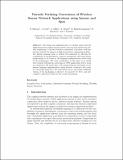Files in this item
Towards verifying correctness of wireless sensor network applications using Insense and Spin
Item metadata
| dc.contributor.author | Sharma, Oliver | |
| dc.contributor.author | Lewis, Jonathan Peter | |
| dc.contributor.author | Miller, Alice | |
| dc.contributor.author | Dearle, Alan | |
| dc.contributor.author | Balasubramaniam, Dharini | |
| dc.contributor.author | Morrison, Ronald | |
| dc.contributor.author | Sventek, Joe | |
| dc.contributor.editor | Pasareanu , C. S. | |
| dc.date.accessioned | 2011-04-04T12:04:39Z | |
| dc.date.available | 2011-04-04T12:04:39Z | |
| dc.date.issued | 2009 | |
| dc.identifier | 6247473 | |
| dc.identifier | bf44e82a-f101-42af-915a-a9e332514229 | |
| dc.identifier | 000268327800015 | |
| dc.identifier | 70350680647 | |
| dc.identifier.citation | Sharma , O , Lewis , J P , Miller , A , Dearle , A , Balasubramaniam , D , Morrison , R & Sventek , J 2009 , Towards verifying correctness of wireless sensor network applications using Insense and Spin . in C S Pasareanu (ed.) , Model Checking Software : 16th International SPIN Workshop, Grenoble, France, June 26-28, 2009, Proceedings . Lecture Notes in Computer Science , vol. 5578 , Springer , pp. 223-240 , 16th International SPIN Workshop on Model Checking in Software , Grenoble , France , 26/06/09 . https://doi.org/10.1007/978-3-642-02652-2_19 | en |
| dc.identifier.citation | conference | en |
| dc.identifier.isbn | 978-3-642-02651-5 | |
| dc.identifier.isbn | 978-3-642-02652-2 | |
| dc.identifier.issn | 0302-9743 | |
| dc.identifier.other | ORCID: /0000-0002-5093-0906/work/77132539 | |
| dc.identifier.uri | https://hdl.handle.net/10023/1804 | |
| dc.description.abstract | The design and implementation of wireless sensor network applications often require domain experts, who may lack expertise in software engineering, to produce resource-constrained, concurrent, real-time software without the support of high-level software engineering facilities. The Insense language aims to address this mismatch by allowing the complexities of synchronisation, memory management and event-driven programming to be borne by the language implementation rather than by the programmer. The main contribution of this paper is all initial step towards verifying the correctness of WSN applications with a focus on concurrency. We model part of the synchronisation mechanism of the Insense language implementation using Promela constructs and verify its correctness using SPIN. We demonstrate how a previously published version of the mechanism is shown to be incorrect by SPIN, and give complete verification results for the revised mechanism. | |
| dc.format.extent | 18 | |
| dc.format.extent | 367637 | |
| dc.language.iso | eng | |
| dc.publisher | Springer | |
| dc.relation.ispartof | Model Checking Software | en |
| dc.relation.ispartofseries | Lecture Notes in Computer Science | en |
| dc.subject | Concurrency | en |
| dc.subject | Distributed systems | en |
| dc.subject | Formal Modelling | en |
| dc.subject | Wireless Sensor Networks | en |
| dc.subject | State concurrent systems | en |
| dc.subject | Automatic verification | en |
| dc.subject | Model | en |
| dc.subject | QA76 Computer software | en |
| dc.subject.lcc | QA76 | en |
| dc.title | Towards verifying correctness of wireless sensor network applications using Insense and Spin | en |
| dc.type | Conference item | en |
| dc.contributor.sponsor | EPSRC | en |
| dc.contributor.institution | University of St Andrews. School of Computer Science | en |
| dc.contributor.institution | University of St Andrews. Office of the Principal | en |
| dc.identifier.doi | 10.1007/978-3-642-02652-2_19 | |
| dc.identifier.grantnumber | EP/C014782/1 | en |
This item appears in the following Collection(s)
Items in the St Andrews Research Repository are protected by copyright, with all rights reserved, unless otherwise indicated.

